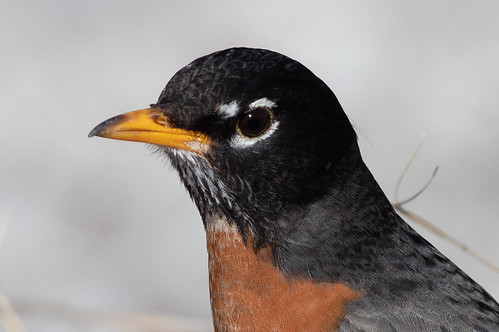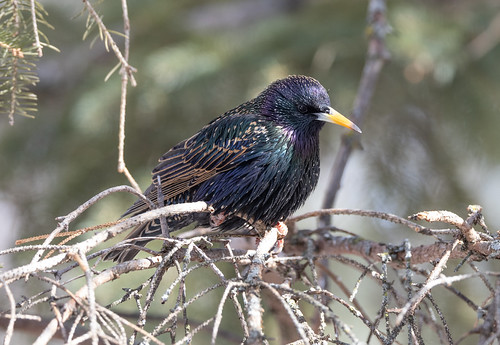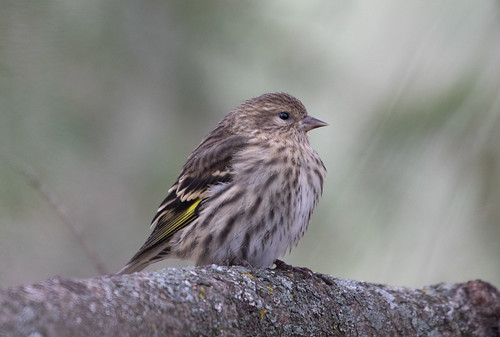Friday, April Fool’s Day, was sunny, and the temperature crept into the low 40s. I still had at least 100 redpolls at my feeder, filling the air with their exuberant chattering, but for the first time in my yard this year, I also heard a distant robin singing away, too. I overslept until a half hour after sunrise, so I don’t know if he started up before dawn—he was not singing when I started my sound recorder at about 7:30, but he piped in an hour or so after that. By Sunday, I was hearing robins before dawn, calling and singing persistently if not close to my recorder.
My Friday morning recording caught redpolls chattering away when suddenly a Merlin flew over. The redpolls instantly quieted down, but when the coast was clear—just seconds later—they resumed their conversations. (Listen to that interchange here.)
It’s only been in the hour and a half right after sunrise that I can record unadulterated redpoll chattering—well, not completely unadulterated. Crows pipe in on and off along with chickadees and nuthatches, but even though you hear their notes, sometimes from close range, these birds, including the noisiest crows, don’t obscure the redpolls. Their notes are discrete and separated by enough time that it’s easy for a human listener to separate them out from the redpolls. European Starlings produce more chattery calls and imitations strung together so tightly that when they're around, their sounds blend in with and overpower the redpolls’ chatterings. Fortunately, starlings don’t roost near my house, and when they wake up, the flock isn’t in a hurry to get to Peabody Street, so I have made some nice redpoll recordings in early morning before the starlings show up.
Starlings, belonging to a non-native invasive species, are a horrible ecological scourge here in America, where they compete with native cavity nesters, often outright killing bluebirds and even woodpeckers. But they have their lovely qualities, too, which are easy to see and hear if you have an open mind and heart. In spring, their iridescent plumage and brilliant yellow beak arrest my attention, and their ability to mimic natural and human-generated sounds is wonderful. Two or three weeks ago, I thought I had a very early Common Loon calling overhead, but fortunately, I didn’t submit that observation to eBird because my starling recordings this weekend confirmed that one of my starlings was making a spot-on imitation of the loon's flight call. Killdeers will be flying over Peabody Street occasionally starting in a week or two, but I know starlings well enough to recognize their Killdeer imitations right off the bat.
Like most good invasion years when redpolls descend en masse upon the northland, they stick around into April. At least 200 were here on Saturday during a brief morning snowfall, giving my yard a wintry ambiance, but among them was a Pine Siskin singing its zippy spring tune. I didn’t see Pine Siskins regularly this winter, so this seemed as promising a sign of spring as the distant robins.
Like robins, the bulk of Canada Goose migration follows the 37-38º F isotherm. A group of four passed over today (Sunday) right when I was outside to notice and count them, while my recorder caught the sound from my office window.
Most days I've been hearing a cardinal singing somewhere at a distance. Occasionally he comes closer to my yard, and on March 15 he was nice and close for a one-minute song bout while my recorder was set up. I haven't been that lucky since then.
People spending time outdoors on February and March mornings can’t help but notice Black-capped Chickadee songs, though many people don’t realize that whistled Hey, Sweetie! is made by chickadees. Before we learn that mating song, most of us already know the onomatopoeic chicka-dee-dee-dee call. Sure enough, my most welcome vocalization of all this spring has been made by my 19-month-old grandson Walter. He isn’t talking a lot yet, but he does refer to that specific little bird visiting his feeder a “chee-dee.” And last week, I asked him what a chickadee says and made a recording of his answer. I suspect that recording will be one of my favorites for a long time to come.








